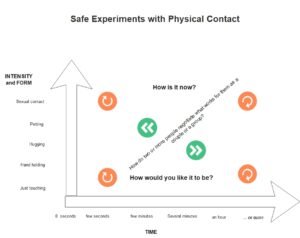There have been a few topics that have taken some time to get on to this web site. Topics such as suicidal thoughts have to be addressed in therapy quite a lot. Physical contact and intimate relationships are yet another area and one that many people meet often in their everyday life.
I have been slow to respond to such issues. I suspect I took the traditional view that some matters can only be the preserve of face-to-face therapy – in the consulting room – where therapist and client relating very directly, one to another.
Well, I have faced up to suicidal thinking, so why not the complexities of physical relationships?!
The illustration, below, may help you consider some practical safe experiments if you are concerned about what is the ‘right’ physical contact for you, A key question is how to communicate with other people to work it all out.
A large obstacle on the scenic route is our reluctance to ask for things. The page on ‘Allowers’ to combat negative thoughts might be worth a visit, along with the page on assertive communication.
The diagram, below, highlights that there are many forms of physical contact. I have a chosen just a few to illustrate that point.
There is a time dimension in my illustration as well. That element cannot be overlooked. Who says that physical contact has to be a fleeting thing or, indeed, go on for ages?
I suspect there are many more choices available to couples and groups when it comes to agreeing on what is ‘acceptable’ physical contact, and how long is it right to stay with it.

How do two or more people negotiate what works for them as a couple or a group? How do they signal when enough is enough, or when more is wanted and what is the ‘more’ that’s wanted.
To help in this process, I have already identified the safe experiment of Special Time. In that special time, I would invite you to consider negotiate several questions incorporated in my illustration.
Those questions go to the heart of small, safe experiments. The experiment will end in a small victory, or a small defeat or something in-between. In either case, it helps to consider: what do I do to build on my victories, and what do I do, a little different, in the face a small defeat?
Is this a feasible focus of attention during Special Time?
In addition, I suspect we will agree that this page will tax our skills as communicators. I do offer some comment on these skills. Good communications are not as common-sense as we might think so I’d ask you to consider how to conduct yourself, one with the other.
I do not want to offer more prescription about what might work for you so this page on a safe experimentation is brief (for once!). I will offer one practical question related ot my illustration: do you hold hands in public?
If so, what does it do for you?
If not, what might it do for you? Is this another subject for special time!
I will leave you to work out the detail and I trust that other parts of the website – identified by the hyperlinks – will help you express your curiousity about what is possible.
There are some further leads listed below.
Return to
What actions might contribute to safe experiments?
